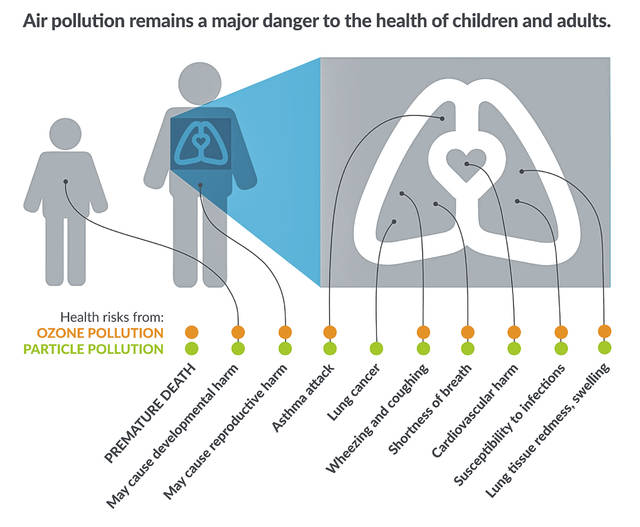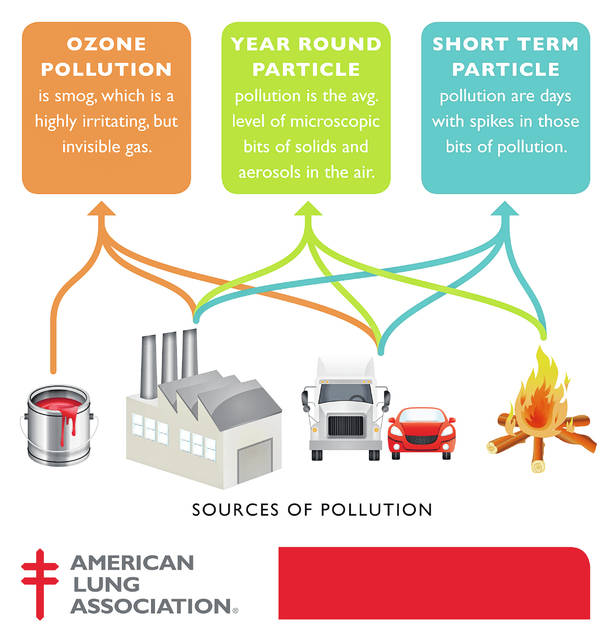

WILMINGTON — Clinton County received a grade of F for ozone pollution in the annual “State of the Air” report by the American Lung Association.
Each year the “State of the Air” provides a report card on the two most widespread outdoor air pollutants — ozone pollution, also known as smog, and particle pollution, also called soot. No monitor for particle pollutants exists in Clinton County (most counties don’t have monitors) and thus no information is collected on local soot pollution.
In the three years tracked in the Lung Association report, 2015 through 2017, Clinton Countians were exposed to 10 days when the amount of ozone was unhealthful. All 10 of those days were classified in the report as “unhealthy for sensitive populations”.
The other two categories for differentiating high ozone days are “unhealthy” and “very unhealthy”, which are used when ozone pollution levels reach ranges that are still more severe than “unhealthy for sensitive populations”.
Ken Fletcher, director of advocacy for the Lung Association in Ohio, said, “Ozone especially harms children, older adults and those with asthma and other lung diseases. When older adults or children with asthma breathe ozone-polluted air, too often they end up in the doctor’s office, the hospital or the emergency room. Ozone can even shorten life itself.”
This is the 20th annual “State of the Air” report from the American Lung Association. And though the F grade for ozone that Clinton County received this time around is concerning, the most recent consecutive four annual reports have seen the county post its best ozone data over the report’s 20-year period.
Fletcher said Clinton County has definitely gotten better over the years in regards to ozone, but there is still “a ways to go.”
Clinton County posted its worst ozone level for the three-year tracking periods for the period from 1997 through 1999. For that set of years, the county’s “annual weighted average number” of unhealthful ozone days was 54.3. That compares to the most recent report’s weighted average number of 3.3 which, you will recall, is assigned an F grade. But it can be noted that 3.3 is barely an F as the weighted average number of 3.2 is a D.
Over the 20 years of tracking, it was for the 2013 through 2015 time span that Clinton County earned its best ozone grade. That’s when it received a C grade for a weighted average number of 2.
Prior to the most recent four annual reports, the next best Clinton County ozone report covered the 2008 through 2010 period, which overlaps the Great Recession.
In this year’s report, 197 counties nationwide received an F for ozone.
Five of those counties — Butler, Clermont, Clinton, Hamilton, and Warren Counties — are in the southwest Ohio region, noted Southwest Ohio Air Quality Agency spokesperson Joy Landry. The agency monitors ozone in those counties, and Landry described the ozone problem in southwest Ohio a regional issue.
Those counties are all part of the Ohio River Valley, and the topography is such that an air mass “just kind of sits there,” she said.
Fletcher, for his part, said that often ozone pollution is not created in the area that’s impacted, and ozone pollution can drift into rural areas from elsewhere.
Similarly, Clinton County Health Department’s Environmental Health Director Matt Johannes, who emphasized he and the local health department do not handle air quality matters, said his initial thinking for why rural Clinton County experiences unhealthful ozone levels includes its proximity to large cities, perhaps especially Cincinnati.
He added that Clinton County’s prevailing winds often blow in from the southwest, making Clinton County downwind of Cincinnati.
Johannes also mentioned Interstate-71 car and truck traffic in the county as a potential factor for a rural area having a high ozone level.
When Lung Association spokesperson Fletcher was asked about commercial aircraft take-offs and landings at the Wilmington Air Park, he said anything that burns fossil fuels can be a source of ozone pollution.
Who is at risk from breathing ozone? According to the Lung Association, anyone who spends time outdoors where ozone pollution levels are high may be at risk.
But five groups of people who are especially vulnerable to the effects of breathing ozone are: children and teens; anyone 65 or older; people who work or exercise outdoors; people with existing lung diseases, such as asthma and chronic obstructive pulmonary disease (also known as COPD, which includes emphysema and chronic bronchitis); and people with cardiovascular disease.
Reach Gary Huffenberger at 937-556-5768.



